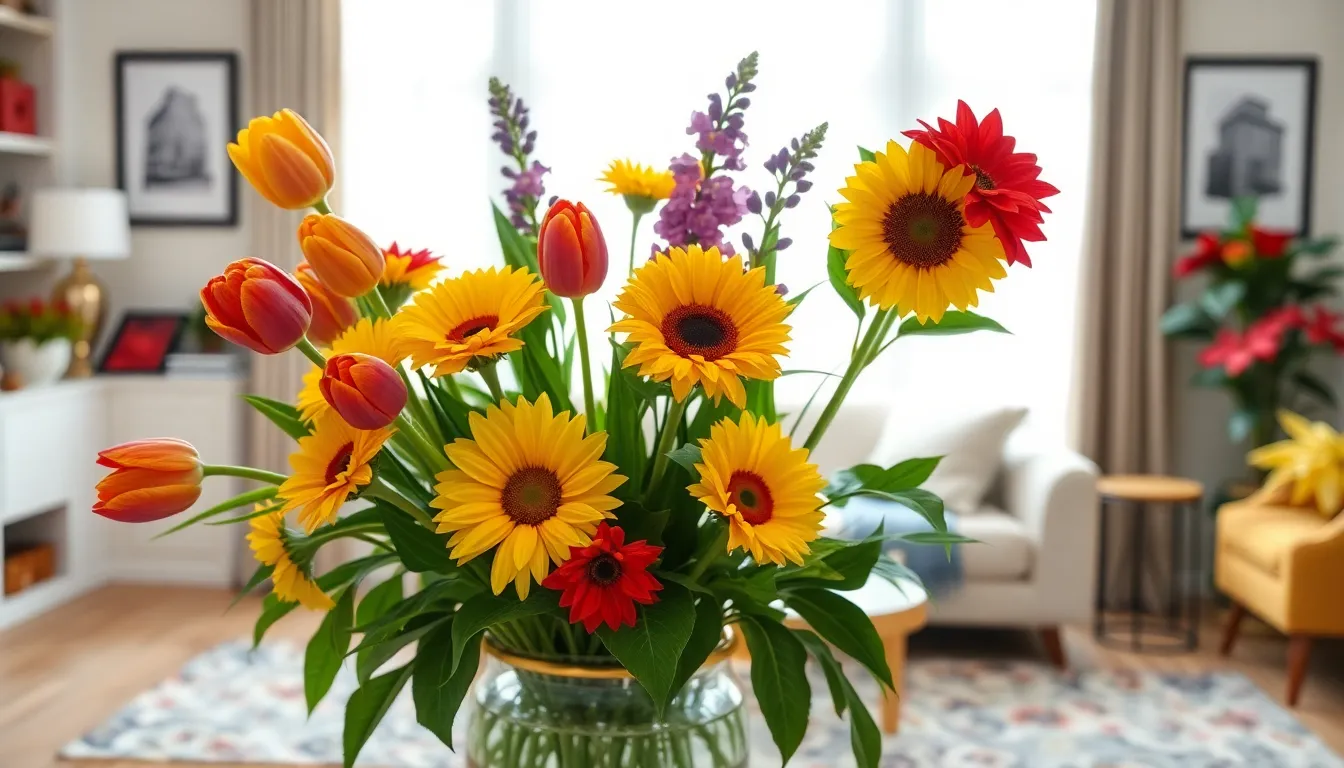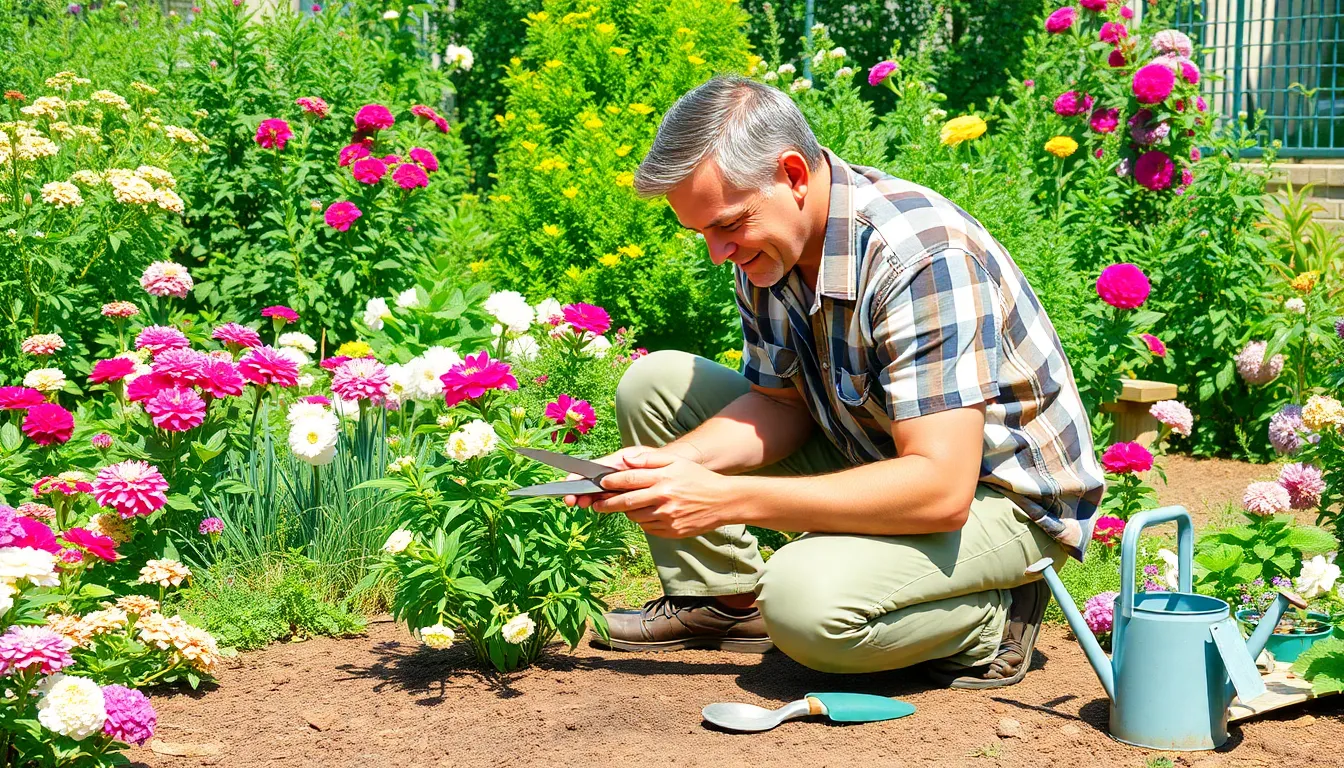Flowers have a magical way of brightening up any space, but arranging them can feel like trying to solve a Rubik’s Cube blindfolded. Fear not! With a few simple tips and a dash of creativity, anyone can transform a bunch of blooms into a stunning centerpiece that’ll make even the grumpiest houseplant green with envy.
Table of Contents
ToggleUnderstanding Flower Arrangement Basics
Creating beautiful flower arrangements involves understanding some foundational concepts. Learning these basics simplifies the process and enhances creativity.
Types of Flower Arrangements
Several types of flower arrangements exist, each serving a unique purpose. Bouquets typically showcase a collection of flowers, while centerpieces focus on enhancing dining environments. Wreaths symbolize continuity and are often used for special occasions. Cascading arrangements create dramatic effects, flowing downward in a visually appealing manner. Finally, ikebana emphasizes minimalism and balance, highlighting individual flowers’ beauty.
Essential Tools and Supplies
The right tools make flower arranging easier and more enjoyable. Floral scissors provide clean cuts, essential for flower longevity. A sturdy vase supports the arrangement and enhances aesthetics. Floral foam may stabilize stems, ensuring proper hydration. Wire and tape assist in securing flowers and maintaining structural integrity. Consider using a flower food mixture to increase vibrancy and lifespan. Having these supplies readily available improves the overall experience of arranging flowers.
Selecting the Right Flowers

Choosing the right flowers plays a crucial role in creating an appealing arrangement. Various factors influence this decision, including seasonality, color, and personal preference.
Seasonal Flower Choices
Seasonal flowers provide freshness and vibrancy to arrangements. Spring brings tulips and daffodils, while summer offers sunflowers and lilies. Autumn showcases chrysanthemums and asters, and winter highlights poinsettias and evergreens. Selecting flowers in season ensures they’re readily available and often more affordable. Availability varies, so using local florists can enhance options.
Color Theory in Flower Arranging
Color theory significantly impacts the effectiveness of a flower arrangement. Complementary colors, such as red and green, create a vibrant contrast, energizing the space. Analogous colors, like yellow, orange, and red, deliver a harmonious effect, enhancing cohesion. The use of monochromatic palettes brings elegance and simplicity, ideal for formal settings. Understanding these color dynamics helps guide choices, ensuring arrangements resonate with the intended atmosphere. Each color evokes specific emotions, so selecting based on the desired mood enriches the overall presentation.
Step-by-Step Guide to Arranging Flowers
Creating a beautiful floral arrangement starts with a few essential steps. Following these directions can enhance the process and outcome significantly.
Preparing the Flowers
Begin by trimming the stems at an angle to maximize water absorption. Removing excess leaves prevents bacterial growth, keeping the water fresh. It’s vital to fill a clean bucket with water, allowing the flowers to hydrate. Additionally, consider using floral preservatives to extend their lifespan. Each flower type may need specific care; consult guidelines for delicate blooms like lilies or sturdy options like sunflowers.
Choosing the Right Vase
Select a vase that complements the flower arrangement’s style and size. Tall flowers benefit from a sturdy, tall vase while shorter arrangements thrive in compact containers. Clear glass vases often showcase the beauty of stems and water, enhancing the visual appeal. For a more rustic feel, ceramic or metal options work well. Ensure the vase is clean and filled with fresh water to enrich the flowers. Factor in the arrangement’s final placement when choosing the vase’s shape and color for continuity in design.
Creative Tips for Unique Arrangements
Creative arrangements elevate floral displays. Unique techniques enhance visual interest and overall appeal.
Incorporating Foliage and Filler Flowers
Foliage adds depth and structure to arrangements. It acts as a backdrop for focal flowers. Consider using varieties like eucalyptus or ferns for texture. Filler flowers, such as baby’s breath or asters, contribute softness. They bridge gaps between larger blooms. Balance is key; arranging foliage and fillers around primary flowers creates harmony. Complementary greens highlight the main colors, enhancing the effect. This method enriches the visual layers within an arrangement, promoting an organic feel. Fresh leaves and delicate fillers breathe life into the design, providing a natural aesthetic.
Experimenting with Shapes and Textures
Shapes and textures play crucial roles in flower arrangements. Mixing round blooms with elongated stems creates visual contrast. Curved lines bring a sense of movement, guiding the viewer’s eye. Textured flowers, like thistles or hydrangeas, enhance tactile interest. Use varying heights to achieve a dynamic profile. Low arrangements provide intimacy, while tall designs evoke drama. Exploring asymmetrical layouts generates intrigue, departing from traditional symmetry. Layering different shapes promotes a lively display. Taking risks with forms and textures ultimately yields captivating arrangements that draw attention.
Arranging flowers is an art that anyone can master with a little practice and creativity. By understanding the basics and utilizing the right tools, individuals can transform their spaces into vibrant displays of nature. Seasonal flowers not only ensure freshness but also enhance the overall aesthetic.
Experimenting with color theory and various shapes adds depth and interest to arrangements. With these insights and techniques, anyone can create stunning floral designs that brighten up any environment. Embrace the joy of flower arranging and let creativity flourish in every bouquet.



